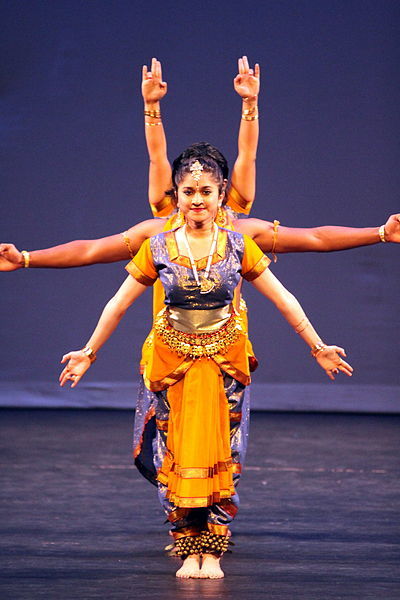What Creature Has 1 Head, 6 Arms And 2 legs?
 The above image is a common dance pose, used to create the illusion of a multi-limbed deity. The dancer in the front has her hands in the down position, the dancer in the middle has her hands in the center position and the dancer in the back has her hands in the up position.
The above image is a common dance pose, used to create the illusion of a multi-limbed deity. The dancer in the front has her hands in the down position, the dancer in the middle has her hands in the center position and the dancer in the back has her hands in the up position.
Other than keeping hands to the respective sides, there is no restriction on the positions. For example, the dancer in the middle could have her left hand in the down position, and her right hand in the up position.
How many ways can 3 dancers recreate this dance illusion?
Image credit: Wikipedia
If you want another problem on multi-limbs, check out The Math Behind The Perfect Man .
This section requires Javascript.
You are seeing this because something didn't load right. We suggest you, (a) try
refreshing the page, (b) enabling javascript if it is disabled on your browser and,
finally, (c)
loading the
non-javascript version of this page
. We're sorry about the hassle.
8 solutions
what does '!'sign after 3 mean ??
Log in to reply
The '!' sign refers to factorial of a number. For example, n ! is pronounced as "n factorial" and it is calculated as the product of all natural nos. till n , i.e.,
n ! = n ( n − 1 ) ( n − 2 ) . . . . . 3 . 2 . 1 = 1 . 2 . 3 . 4 . . . . . ( n − 1 ) n
You can write it either way...
Log in to reply
thanks for the answer, I have now understood the meaning of ! in the answers
Factor is denoted as '!'
Log in to reply
Not factor, n ! denotes factorial of a number n . There is a lot of difference between factor and factorial...
factorial
i don't understand what ! mean
Log in to reply
@Subrota Roy Hmm....see my reply to the first comment made by Rishabh Tripathi in this discussion. He had the same doubt and I clarified it in my reply. If you have any further doubts, drop me a line in the comments... :)
Can you prove beal conjecture
Log in to reply
I don't see how it is related to this problem !! Also, I don't even know what Beal's conjecture is, let alone prove it.
27
Log in to reply
27..what ?? The answer is ( 3 ! ) 2 which is equal to 3 6 .
( 3 ! ) 2 = ( 3 × 2 × 1 ) 2 = 6 2 = 3 6
I think it would be good for me and also others if comments are made such that others can understand what the person is trying to say!!
No. of ways of changing positions of hands is 3! and no. of ways they can change their positions is 3! ... so total number of ways they can perform this dance is (3!)^2
what is the meaning of exclamation point in the problem.question ?
Total position =3, And each people has 2 hands. So the arrangement of hands without restriction one side is 3!. same for both sides simultaneously of hands is 3!^2
Solved it in first attempt. https://www.youtube.com/watch?v=FJbmB9k2Y88
In each side, there are three positions and three dancers to fill each of the positions. For example, on the right side, there are three right hands (from the three dancers) that can fill the top most position. After the topmost, there would be two right hands then the same with the bottom-most. So, on the right side there are 3! possible combinations. The same with the left side. So we have (3!)^2
N possibilities 3 x K possibilities 3 = 9 or 3²
3 positions for each limb of 3 girls = (3)^2
I think there are a few more possibilities.
u missed the factorial sign
possible way for arrange the position of three dancer 3!,possible way for arrange there hands is also 3! so total way is (3!)^2
total is (3!)
It is said that the 3 dancers can change the position of their hands only on the side that the hand points to, i.e., the left hand of one cannot make a position of right side and vice-versa.
Then, the hands that recreate the left part of the dance pose can be rearranged in 3 P 3 = 3 ! ways as there are 3 hands on left side (one from each person) and the other 3 hands of the dancers recreate the right side of the dance pose can also similarly be arranged in 3 P 3 = 3 ! ways.
So, total no. of ways = 3 ! × 3 ! = ( 3 ! ) 2